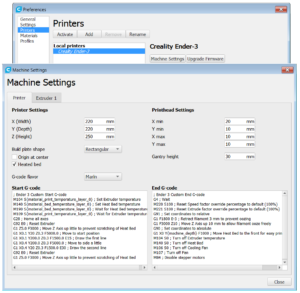

Ideal retraction settings for the most common materials (PLA, ABS, PETG): Coasting: Turns of extrusion for the last millimeters of a print line.įor more information about retraction and calibration models, we wrote this article.Wiping: Makes a short travel move inwards before traveling to another place.May not always be recommended for every print. Combing: Turns off retraction and modifies travel moves to go over the infill to deposit any plastic that oozes out.There are also a few features that can help with stringing or other artifacts that come from oozing: Maximum retraction countspecifies the number of retractions that can be made along a segment of filament.Retraction speed is mostly limited by the extruder, it is best to start low (20 mm/s) and move up testing it with a stringing test.In Bowden setups, this distance tends to be higher (3 mm – 6 mm). Retraction distance is how much filament is pulled.

There are a few parameters to modify to tweak retraction. If retraction settings are too aggressive the filament can become chafed and generate another set of problems. When retraction isn’t finely tuned, stringing appears. On Bowden printers like stock Ender 3 this phenomenon is more pronounced. To move the printhead without depositing any plastic the extruder must retract the filament. Molten plastic would continue to drip because of the pressure build-up on the nozzle. When the printer needs to stop extruding just stopping to advance the filament isn’t enough. A sensible range would be 0.1 to 0.3 for a 0.4 nozzle.įor more information about layer heights, check out our article on the topic It is recommended not to use layer height over 80% of the nozzle size. Nozzle size also limits the layer height. Choosing the right number for each print depends on what is the purpose of the print. With bigger layer heights print time decreases but detail and strength decrease as well. Layer height drastically influences print time, detail, and strength. On Ender 3, for example, layer height goes up in multiples of 0.04 mm (0,08, 0,12, 0,18, etc.). The set of best layer heights are commonly known as “Magic numbers”. Layer height theoretically could be set to any thickness, but the mechanical construction of each printer makes some thicknesses better than others. Ideal Bed temperature for the most common materials: There are many print surfaces available in the market that also help to get a good first layer, retain the part while printing and release it when cooled down.Īs it is with extrusion temperatures, ideal bed temperatures should be only a starting point to test your specific setup and filament choice. Getting the bed temperature right greatly increases your chances of success. Ideal printing temperature for the most common materials:Ī heated bed has become a staple in 3D printing. There can even be differences between spools from the same manufacturer if the fabrication process isn’t carefully controlled. Every manufacturer has its own blend hence the different optimal extrusion temperatures. Ideal printing temperatures are a starting point as you should find out which one is the best for your combination of filament and printer. This depends on the extrusion temperature and the part cooling.

Then there’s also the question of what happens once the material is deposited and how strongly it bonds with the previous layer. Getting the temperature just right lets you push plastic through the extruder but without uncontrolled dripping. With polymers, there is a temperature range where it starts to flow, and it becomes less viscous the higher the temperature is increased. In thermoplastics melting temperature isn’t fixed as it is with water for example. Filaments are made from different polymers that have different melting temperatures so extrusion temperature depends on what filament you choose. The most common 3D printing technology today is based on melting plastic filament and depositing in an organized manner. Then simply adapt the print settings of that profile to suit your needs. Use the Standard Cura Profiles as a starting-off pointĬura offers different profiles for most filament types (PLA, ABS, PETG, TPU, etc.) and these come with settings that generally work quite well. Below you’ll find an explanation for each of the parameters that you shouldn’t ignore. Once you master the main settings you can continue with the vast number of advanced features that the different slicers offer. When starting with 3D printing you should only really focus on a few parameters. Ideal Ender 3 Printing settings for each filament type.Use the Standard Cura Profiles as a starting-off point.Different settings and their Importance.


 0 kommentar(er)
0 kommentar(er)
